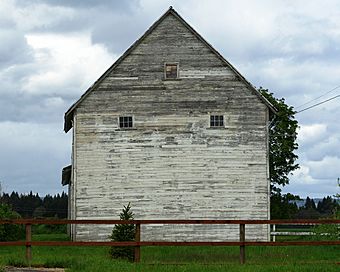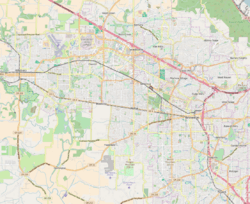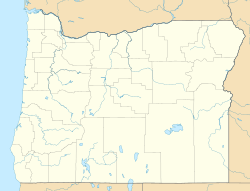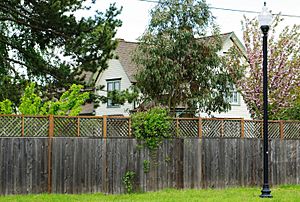Manning–Kamna Farm facts for kids
Quick facts for kids |
|
|
Manning-Kamna Farm
|
|

Barn in 2009
|
|
| Location | Washington County, Oregon, USA |
|---|---|
| Nearest city | Hillsboro, Oregon |
| Built | 1880s to 1920s |
| NRHP reference No. | 07001077 |
| Added to NRHP | October 10, 2007 |
The Manning–Kamna Farm is a special old farm near Hillsboro, Oregon in Washington County, Oregon, USA. It was first settled in the 1850s. Today, ten buildings from the farm still stand. These buildings were constructed between 1883 and 1930.
One of the main buildings is the large farmhouse. These ten structures were added to the National Register of Historic Places in 2007. They show what a farm in this area looked like around the early 1900s. For many years, until the 1950s, the farm was used to grow seeds. These included seeds for plants like rye grass and vetch. Other buildings on the property include a barn, a smokehouse, a pumphouse, a woodshed, and a privy.
Contents
Farm History
Farming started here in 1851. A man named Carlos Dudley Wilcox and his wife Elizabeth settled on the land. They claimed it under a special law called the Donation Land Claim Act. This law gave land to settlers in the Oregon Country. Carlos came to Oregon in 1847 with his family. He married Elizabeth Scoggin when she was 15 years old.
Carlos and Elizabeth had five children on their 640-acre farm. In 1857, Carlos sold 62 acres of the land. The Wilcoxes divorced in 1872. Elizabeth received the southern part of the farm. Carlos kept the northern part and sold half of it in 1874.
The Manning Family
Elizabeth remarried on January 29, 1874. Her new husband was Louis Manning, who was born in New York. Louis had lived in many places before settling in Washington County. On Elizabeth's 320-acre farm, they raised her children. They also grew different kinds of crops.
Between 1876 and 1883, the Mannings built a new farmhouse. They also built a large two-story barn in the early 1880s.
The Kamna Family Takes Over
Herman Kamna (1870–1924) came from Germany with his family in 1886. He married Anna Rehse in 1900. In June 1903, the couple bought 175 acres from the Mannings. The Mannings kept a small part of the farm, including the farmhouse, for their lifetime. They stayed on the farm until Louis died in 1910 and Elizabeth in 1916. After that, the Kamnas moved into the farmhouse.
The Kamnas had four children. One son, Edgar, later took over the farm work. Around 1910, the Kamna family added to the barn. They built a second addition around 1920. They kept adding more buildings in the early 1900s. These included a woodshed, a privy, a pumphouse, a chicken coop, a smokehouse, a potato shed, and a canning shed. The last building added was a garage in the 1920s.
In the 1920s, the family added indoor plumbing to the farmhouse. This meant they closed off parts of two porches. The Kamnas grew oats, fescue, rye grass, vetch, and sub-clover on the farm. They used the barn to sort and pack the seeds. The family continued farming into the 1950s. In 2007, Wayne Reed and Petrina Pometto owned the farm. The Manning–Kamna Farm was added to the National Register of Historic Places on October 10, 2007.
The Farmhouse
The Manning-Kamna farm is located along northwest Evergreen Road. It is across the street from the city of Hillsboro. The farmhouse is the largest and oldest building on the farm. It was built between 1876 and 1883.
The house is 1.5 stories tall. It has a late Victorian style and is shaped like a cross. This style is called a "cross-wing Western Farmhouse." It has a gabled roof with four porches, one on each corner. The house is made of wood, mostly Douglas-fir. A concrete foundation was added in 2006. The roof is made of composite shingles.
The home has double hung windows, two chimneys, and seven doors. A walkway connects the house to the woodshed next door. Special details include a corbelled chimney and fancy window frames. The porches have decorative wooden brackets above the columns. Inside, the main floor has a kitchen, laundry room, bathroom, dining room, and a parlor. There is also a foyer, a mud room, and a fireplace room with a special Rumford fireplace. Upstairs, there is another bathroom, a sewing room, and three bedrooms.
Other Farm Buildings
The farm covers about 2.22 acres. It has nine other buildings arranged in a rectangle. The farmhouse is in the middle. The barn is to the west, and the privy is on the eastern side.
The Barn
The original two-story barn is the oldest and largest of these buildings. It was built from hand hewn timber posts. It measures 35 feet by 70 feet and has white shiplap siding. The two newer barn buildings are connected to the older part. These newer parts are one story tall. The middle part is 20 feet by 30 feet, and the northernmost part is 20 feet by 20 feet. White board and batten siding was used on the middle part, built around 1910. Tongue and groove siding was used on the end section, added around 1920. The barns were important for the farm's seed growing business.
Other Important Structures
- Woodshed: This building, also called the chop house, is attached to the farmhouse. It is one story tall with a gabled roof. The Kamna family built it in the early 1900s. It was updated in the 1970s and now has a half-bathroom.
- Chicken Coop: Built around 1920, this coop has an unfinished inside and a gabled roof. It measures 12.5 feet by 20 feet and has a dirt floor and shiplap siding.
- Potato Shed: This shed also has shiplap siding and a gabled roof. It measures 16 feet by 22 feet. It has a concrete floor and was built around 1910 to store crops.
- Privy: This is the smallest building, measuring 6 feet by 8 feet. It was used from about 1910 until the 1950s. It had three holes inside, shiplap siding outside, and a cedar shake roof.
- Pumphouse: Built around 1910, this building has a brick foundation and a brick lined well. It is a wood frame structure with a hip roof made of composition shingles. The well provided water for irrigation on the farm.
- Smokehouse: Also built around 1910, the smokehouse had a dirt floor. It measures 8.5 feet by 10.5 feet. It has white shiplap siding and a cedar shake roof.
- Canning Shed: This is the only brick building on the property. It was built in the late 1800s. It was used for canning food, storing food, and as a summer kitchen. It measures 14 feet by 14 feet and has a hipped roof with a wooden ventilation chimney at the top. The brick outside is covered with stucco.
- Garage: The newest building on the farm is the garage, built in the 1920s. It has a gabled roof, exposed rafter tails, and weatherboard siding. It is located between the farmhouse and the barn. It measures 24 feet by 16 feet and has a 10-foot wide double-car garage door. There is one window on each end of the building. Large Pignut Hickory and Black Walnut trees provide shade for the garage.





